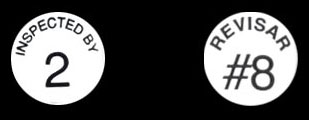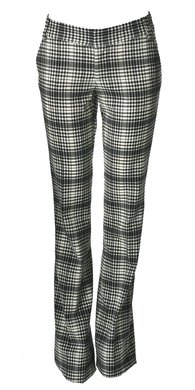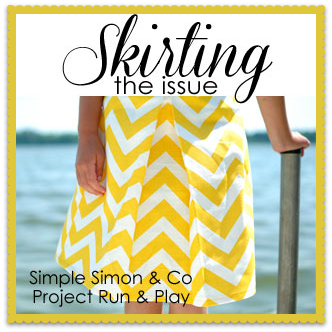I will head over to TJ Maxx or Ross later today–our oldest has her very first high school pep rally on Friday, and she needs a shirt in team colors. Since it’s her first year at a new school, we don’t own a single thing in this entire house that is the exact right shade, so I’ll be hunting through the options on the discount rack at my favorite discount retailers (because that’s SO totally how I roll) to find something that’s (1) the right color and (2) not slutty. For a junior in high school, that’s a tough combination. Her after-school practices are already running so late that there isn’t time between now and then for a mother-daughter shopping date, so Mommy’s going to take one for the team–literally.
Wondering what all that has to do with sewing plaid fabrics? Give it a minute–I’m getting there. While I’m shopping my off-brand retail stores, I’m sure to see some fabulous in-season garments by big(gish)-name designers that don’t seem to have any business being marked down 70% (even in this economic climate). And I would wonder, “Hmmm. What’s wrong with it, I wonder?” That’s how I like to wonder, mostly: as obviously as possible. And preferably aloud.
A large proportion of the time, those garments have some small construction error that means they didn’t meet inspection standards for the brand. Like, know how you’ll find that tag that reads, “Inspected by #8”? These didn’t get her stamp of approval. (For my favorite version of this ever, check out the Monk episode “Mr. Monk Goes to a Fashion Show.”, which I will now totally be watching in the background while I type this.) Many of those garments have tags on them that read “Irregular.” That’s frequently for little mistakes, like that the plaids don’t match at the seams. (See how we came back around there?)
Matching plaid fabrics takes a little more yardage, in order to ensure that there is enough room to manipulate the pattern pieces so they fall on the fabric’s repeat just right. The mark of higher-end garments has always been that the plaids match well, and the mark of knock-offs is frequently that their plaids don’t match at the seamlines. If you’re making your own clothing, do you really want to put in all that time and effort cutting and pinning and sewing and fitting just to have it look like a cheap knock-off when you’re done? No, dear. No, you don’t. Trust me.
Cutting Your Pattern Pieces to Match Plaids Across a Garment
 As you’re constructing a garment, taking the time to line up the repeat in the print or weave of the fabric makes a massive impact on the finished product–even if you can’t always tell how big a deal it’s going to be. For example, on the (in-progress Lisette) jacket above, were the elements of the plaid–the whiter stripes with the red checks that run horizontally and vertically–to fall so they don’t create a continuous pattern across the garment, it breaks up the lines of the jacket and makes it look…off. Sometimes you won’t even be able to put your finger on just what’s wrong, but you’ll know something is. And it’s pretty easy to fix in advance, if you’re paying attention.
As you’re constructing a garment, taking the time to line up the repeat in the print or weave of the fabric makes a massive impact on the finished product–even if you can’t always tell how big a deal it’s going to be. For example, on the (in-progress Lisette) jacket above, were the elements of the plaid–the whiter stripes with the red checks that run horizontally and vertically–to fall so they don’t create a continuous pattern across the garment, it breaks up the lines of the jacket and makes it look…off. Sometimes you won’t even be able to put your finger on just what’s wrong, but you’ll know something is. And it’s pretty easy to fix in advance, if you’re paying attention.
The important part to point out is that this all takes place at the CUTTING stage–if you don’t cut well, all the manipulating at the sewing machine and ripping out seams later won’t make a difference at all. The secret weapon is the notches. See them, up there? And you thought they were just for matching pattern pieces to one another when you’re assembling the garment! Oh, innocent seamstress! Yes, that’s true, they are–but they’re also for matching up pattern designs and repeats as you cut. The image above shows the side seam of the jacket front and back where they will meet–by placing the notches on the same element of the pattern repeat (in this case, the lower band of blackish-navy in the horizontal stripe), I’m able to ensure that as I sew, the design of the fabric will fall along the same repeated element across the entire jacket.
That way, once the seam is stitched, it all lines up nice and clean–creating the illusion that the fabric flows across the shape and lines of the garment, but allowing me to put in seams to shape the fabric to my body. Take a look at the pocket welt, for example. See how it doesn’t match the overall flow of the plaid? That’s deliberate, because by interrupting the design at that seam, I call attention to the element of the welt at the pocket–but I don’t want that same kind of visual disruption on a seam line, where I’m working to create smoothness and flow.
This doesn’t just work on side seams. It can be used for sleeves, as well, where it create a more subtle but even more high-end effect. See the notches on the side front and the front of the sleeve, and how they match the fabric’s repeat?
And now see how once the sleeve is inserted into the jacket, the pattern will flow across not just the body of the jacket, but each sleeve, as well? It creates a much more unified look, and while the average person on the street won’t realize that what they’re seeing is a neatly engineered repeated design across your garment, you’ll see a 183% increase in compliments on your work, and a 251% increase in gasps of, “Did you make that??”*
 It’s a result that’s pretty easy to achieve: just locate the element you want to focus on as you cut, and place one notch on the first pattern piece in a spot that’s easy to duplicate–like the lower dark line here, or even centering the point of the notch on the red stripe, which is super specific. Then, as you cut subsequent pattern pieces from your fabric, lay the correlating notches (the ones that will line up with one another as you assemble the garment later) on the same repeated element–it will be elsewhere on the fabric, but since it’s a repeat, you ought to be able to locate another spot that’s the same as the first spot, and….you see how this works. (Incidentally, this can be applied not just to plaids but to larger-scale graphic or floral repeats, too.) You’ll notice that I cut my notches OUT, rather than in–this makes it easier to pinpoint those bits of repeat and make certain I’m being accurate. If, as you assemble the garment, you find your notches are off by a hair (less than 1/4″), like the image above, I think it’s OK to cheat a bit to preserve the overall integrity of the garment. Just BTW.
It’s a result that’s pretty easy to achieve: just locate the element you want to focus on as you cut, and place one notch on the first pattern piece in a spot that’s easy to duplicate–like the lower dark line here, or even centering the point of the notch on the red stripe, which is super specific. Then, as you cut subsequent pattern pieces from your fabric, lay the correlating notches (the ones that will line up with one another as you assemble the garment later) on the same repeated element–it will be elsewhere on the fabric, but since it’s a repeat, you ought to be able to locate another spot that’s the same as the first spot, and….you see how this works. (Incidentally, this can be applied not just to plaids but to larger-scale graphic or floral repeats, too.) You’ll notice that I cut my notches OUT, rather than in–this makes it easier to pinpoint those bits of repeat and make certain I’m being accurate. If, as you assemble the garment, you find your notches are off by a hair (less than 1/4″), like the image above, I think it’s OK to cheat a bit to preserve the overall integrity of the garment. Just BTW.
Sewing Plaids with Fewer Mistakes
In the end, you ought to get a seam where the plaid simply continues across seams as though they aren’t there. If you’re struggling with the fabric shifting as you sew–and many do, which is infuriating when you’ve spent all that time cutting super accurately–think about switching to your walking foot. This was a revolution for me when I was first sewing plaid: by using the walking foot, you feed the fabric from both above and below, which helps keep the pattern repeat very nicely in line on both pieces of fabric.
 No walking foot? Try LOTS of pins–placing one every repeated element in the edge to be stitched, but no more than 1″ apart (really). This will help stabilize the seam and prevent the puckering and shifting you’ll often see when sewing with plaids.
No walking foot? Try LOTS of pins–placing one every repeated element in the edge to be stitched, but no more than 1″ apart (really). This will help stabilize the seam and prevent the puckering and shifting you’ll often see when sewing with plaids.
I’m off to finish my super-cute jacket–hooray for plaid!
*estimated









Belinda
August 24, 2011 at 12:12 pmWash Away basting tape can be a life saver when working to keep elements “matched” up while sewing.
Deborah
August 24, 2011 at 12:14 pmThat’s the double-sided kind that’s like those strips of Steam-a-Seam, right? I haven’t tried that–but I wonder if it isn’t the same amount of work as tracking down and putting on my walking foot? Thanks, BG!
Belinda
August 24, 2011 at 12:43 pmIt’s double sided tape – adds no bulk even if not washed out. LOVE it. My 15 yr old roll was awful to work with but the new stuff is great! You should stock it in the shop. It’s a bit hard to find locally.
Tons of uses – zippers, bindings, etc.
I especially like to use it when I’m making reversible aprons when stitching needs to be as good on the reverse side as it is on the front side.
Kay (Soubrette Art)
August 24, 2011 at 3:07 pmBoth the walking foot and the basting tape are brilliant ideas. Thanks ladies. But what’s up with patterns drawing the little pointer doohickies inward instead of outward (ie. outside the seam allowance). Half the time I’m cutting along and realize I completely forgot to cut the point because modern patterns don’t draw them “right” (that is the way they used to be when I was a kid learning to sew).
Miquela
August 24, 2011 at 6:18 pmWhat a coinkydink, I was going to make my daughter a pair of shorts tomorrow and she chose a plaid for them. I was going to read up on this very subject tonight!
Clover@farrbetterlife
August 24, 2011 at 7:18 pmDeborah you rock.
Sara
August 24, 2011 at 10:33 pmGreat post! I’m trying to get up the nerve to cut into my plaid suiting and trying to work up double the nerve to sew it into trousers. eek! I’ve been patiently waiting for your Portfolio Pants… did they get put in the back of the line? I’m going to try to sew Vogue 8751, but any pants would be inspirational right now.
Michelle
August 25, 2011 at 2:08 amOk, ok. Here’s the truth. I purposely passed by all the adorable plaids for the jacket pattern because I thought it would be too much work. I think I might make a trip to the shop today.
I’m debating on updating my machine. Pfaff makes one with a built in walking foot. Seems like there are so many times when a walking foot comes in handy, that it might not be the worst idea….hmmmm….
Thanks for the post! Very inspiring.
dana
August 25, 2011 at 10:08 amFunny you would post this today. I’m usually so good about matching up my lines and prints….but I made a pair of plaid pants for Owen last night and TOTALLY botched the match-up on the back. Ugh, they look bad. But the front looks good, so at least I can fool people in the pics 🙂
Rachel at Stitched in Color
August 25, 2011 at 11:11 amGood info, Deborah!
Mitzi
August 25, 2011 at 1:53 pmOH, could you teach me how to line up the prints in my quilting fabric? I hate it when I have to cut a piece of fabric to make a backing and then can’t figure out how to line the prints back up correctly. I’m sure you have a easy breezy way of doing it.
Sue Heinlein
August 29, 2011 at 9:45 amI also take plaids a step further when cutting out – I try to match the grainwise plaid when I can. I like to have the bottom of my garment look like it was one single piece of fabric with both the length and cross plaids matching up.
Tina @ Plaid Fabric
November 4, 2011 at 3:55 amHi
I was looking for some inspiration earlier and stumbled across your site. There are some very neat tips, especially about how to line up the patterns.
Thanks
Mark Le bois
June 11, 2014 at 2:45 amGreat pictures! Thank you! I found some more on this website: http://www.archiexpo.com/architecture-design-manufacturer/plaid-fabric-2691.html